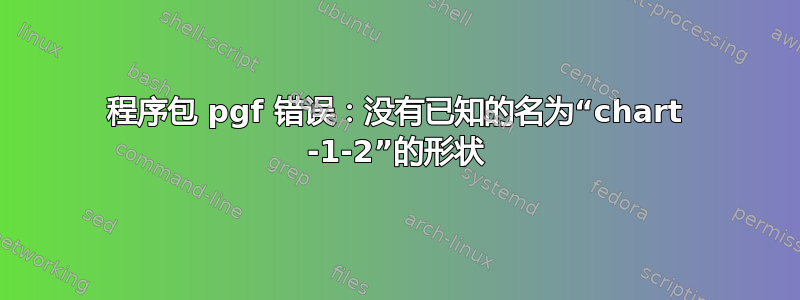
我正在尝试在 Latex 中制作流程图,但一直收到此错误;“包 pgf 错误:没有已知的名为‘图表 -1-2’的形状”
我查过类似的问题,但都没用matrix。有人知道我的问题出在哪里吗?
\documentclass[a4paper, 12pt]{report}
\usepackage{graphicx}
\usepackage{mathtools}
\usepackage{geometry}
\usepackage{tikz}
\usetikzlibrary{matrix,calc,shapes}
%define styles for nodes
\tikzset{ treenode/.style = {shape=rectangle, rounded corners, draw, anchor=center, text width=5em, align=center, top color=white, bottom color=blue!20, inner sep=1ex}, decision/.style = {treenode, diamond, inner sep=0pt}, root/.style ={treenode, font=\Large, bottom color=red!30}, env/.style = {treenode, font=\ttfamily\normalsize}, finish/.style = {root, bottom color=green!40}, dummy/.style = {circle,draw}}
%create useful shortcuts
\newcommand{\yes}{edge node [above] {yes}}
\newcommand{\no}{edge node [left] {no}}
\begin{document}
\begin{tikzpicture}
\matrix (chart)
[
matrix of nodes,
column sep = 3em,
row sep = 5ex,
column 1/.style = {nodes={treenode}},
column 2/.style = {nodes={treenode}}
]
{
& |[root]| Collect data \\
& Preliminary checks on data quality \\
& Diagnostics for relationships and strong interactions \\
Remedial measures & \\
& | [decision]| Are remedial measures needed? \\
& Determine several potential useful subsets of explanatory variables; include known essential variables \\
& Investigate curvature and interaction effects more fully \\
Remedial measures & Study residuals and other diagnostics \\
& | [decision]| Remedial measures needed? \\
& Select tentative model \\
& | [ decision]| Validity checks? \\
& | [finish]| Final regression model \\
};
\draw(chart -1-2) edge (chart -2-2)
\draw(chart -4-1.west) -- ++(-1,0) node[midway,above]{yes} |- (chart -3-2.west)
\draw(chart - 9 - 2.west) --++(-1,0) node[midway,above]{yes} |- (chart -7 -2.west)
\draw(chart -11 -2.west) --++(-2,0) node [midway,above] {no} |- (chart -1 -2.west)
\draw(chart -5 -2 ) \no (chart -6-2)
\draw(chart -9-2) \no (chart -10-2)
\draw(chart -11-2) \yes (chart -12- 2);
\end{tikzpicture}
\end{document}
答案1
编辑:在流程图的右侧添加了括号。
您的流程图可以通过使用chains库来简单绘制。至少代码更短、更清晰,也更不容易出错。例如,在您的 MWE 中,除了编写坐标名称和行终止的错误(在另一个答案中已更正)之外,还遗漏了节点之间的许多箭头,而且流程图比页面高得多。该流程图可以适合,在 MWE 中采取了以下两项措施:增加文本区域大小并使用更宽的节点:
\documentclass[a4paper, 12pt]{report}
\usepackage[showframe, % in real document remove this option
margin=25mm]{geometry}
\usepackage{tikz}
\usetikzlibrary{arrows.meta,
calc, chains,
decorations.pathreplacing,%
calligraphy,% had to be after decorations.pathreplacing
positioning,
quotes,
shadows, shapes.geometric}
\tikzset{
BC/.style = {
decorate,
decoration={calligraphic brace, amplitude=6pt,
pre =moveto, pre length=1pt,
post=moveto, post length=1pt,
raise=1mm},
ultra thick,
pen colour={#1}
},
}
\begin{document}
\centering
\begin{tikzpicture}[
node distance = 5mm and 8mm,
start chain = A going below,
%
arr/.style = {-Straight Barb, semithick},
base/.style = {draw, rounded corners,
top color=white, bottom color=blue!20,
text width=68mm, minimum height=8mm,
align=center, drop shadow,
on chain=A},
start/.style = {base, bottom color=red!20, text width=34mm},
stop/.style = {base, ellipse, text width=34mm,
bottom color=green!40},
process/.style = {base, fill=orange!30},
% io/.style = {base, trapezium, trapezium stretches body,
% trapezium left angle=70, trapezium right angle=110,
% fill=blue!30},
decision/.style = {base, bottom color=cyan!50, diamond, aspect=2, text width=34mm},
lbl/.style = {label=above left:#1, font=\footnotesize}
]
\begin{scope}[nodes={join=by arr}]
\node [start] {Collect data}; % <-- A-1
\node [process] {Preliminary checks on data quality};
\node [process] {Diagnostics for relationships and strong interactions Remedial measures};
\node [decision] {Are remedial measures needed?};
\node [process] {Determine several potential useful subsets
of explanatory variables; include known essential variables};
\node [process] {Investigate curvature and interaction effects more fully
Remedial measures};
\node [process] {Study residuals and other diagnostics};
\node [decision] {Remedial measures needed?};
\node [process] {Select tentative model};
\node [decision] {Validity checks?};
\node [stop] {Final regression model}; % <-- A-11
\end{scope}
% nodes in the left branch
\node [process, text width=32mm,
left=of $(A-3.west)!0.5!(A-3.west |- A-4)$] {Remedial measures needed?};
\node [process, text width=32mm, left=of A-7] {Remedial measures};
% connection not considered in "join" macro
\coordinate[left=of A-12] (aux);
\draw[arr] (A-10.west) node[lbl=No] {} -| (aux) |- (A-2);
\draw[arr] (A-12) |- (A-3);
\draw[arr] (A-4.west) node[lbl=Yes] {} -| (A-12);
%
\draw[arr] (A-13) |- (A-6);
\draw[arr] (A-8.west) node[lbl=Yes] {} -| (A-13);
% path edge quotes in main branch
\path (A-4) to ["No"] (A-5.north)
(A-8) to ["No"] (A-9.north)
(A-10) to ["Yes"] (A-11.north);% braces
\begin{scope}[nodes={text width=24mm, align=left, right=3mm}]
\coordinate (aux) at (A-1.north -| A-2.east);
\draw[BC=red] (aux) --
node {some text in two rows} (A-4.south -| aux);
\draw[BC=red] (aux |- A-5.north) --
node {some text longer test in three rows} (A-5.south -| aux);
\draw[BC=red] (aux |- A-6.north) --
node {some text in two rows} (A-9.south -| aux);
\draw[BC=red] (aux |- A-10.north) --
node {some text in two rows} (A-10.south -| aux);
\end{scope}
\end{tikzpicture}
\end{document}
答案2
问题在于您在节点名称中添加的空格。请注意这些问题,因为chart -1-2不同于chart-1-2!
此外,每个 TikZ 命令都应以分号结尾。
尝试一下这个,但是你仍然需要扩展所有内容并检查节点之间的连接,我认为:
\documentclass[a4paper, 12pt]{report}
\usepackage{graphicx}
\usepackage{mathtools}
\usepackage{geometry}
\usepackage{tikz}
\usetikzlibrary{matrix,calc,shapes}
%define styles for nodes
\tikzset{ treenode/.style = {shape=rectangle, rounded corners, draw, anchor=center, text width=5em, align=center, top color=white, bottom color=blue!20, inner sep=1ex}, decision/.style = {treenode, diamond, inner sep=0pt}, root/.style = {treenode, font=\Large, bottom color=red!30}, env/.style = {treenode, font=\ttfamily\normalsize}, finish/.style = {root, bottom color=green!40}, dummy/.style = {circle,draw}}
%create useful shortcuts
\newcommand{\yes}{edge node [above] {yes}}
\newcommand{\no}{edge node [left] {no}}
\begin{document}
\begin{tikzpicture}
\matrix (chart)
[
matrix of nodes,
column sep = 3em,
row sep = 5ex,
column 1/.style = {nodes={treenode}},
column 2/.style = {nodes={treenode}}
]
{
& |[root]| Collect data \\
& Preliminary checks on data quality \\
& Diagnostics for relationships and strong interactions \\
Remedial measures & \\
& |[decision]| Are remedial measures needed? \\
& Determine several potential useful subsets of explanatory variables; include known essential variables \\
& Investigate curvature and interaction effects more fully \\
Remedial measures & Study residuals and other diagnostics \\
& |[decision]| Remedial measures needed? \\
& Select tentative model \\
& |[decision]| Validity checks? \\
& |[finish]| Final regression model \\
};
\draw(chart-1-2) edge (chart-2-2);
\draw(chart-4-1.west) -- ++(-1,0) node[midway,above]{yes} |- (chart-3-2.west);
\draw(chart-9-2.west) --++(-1,0) node[midway,above]{yes} |- (chart-7-2.west);
\draw(chart-11-2.west) --++(-2,0) node [midway,above] {no} |- (chart-1-2.west);
\draw(chart-5-2) \no (chart-6-2);
\draw(chart-9-2) \no (chart-10-2);
\draw(chart-11-2) \yes (chart-12-2);
\end{tikzpicture}
\end{document}




